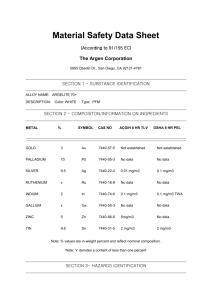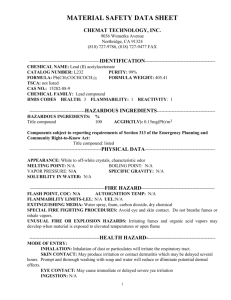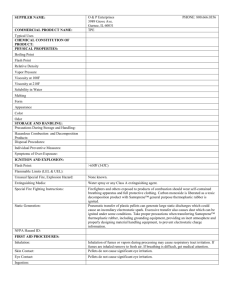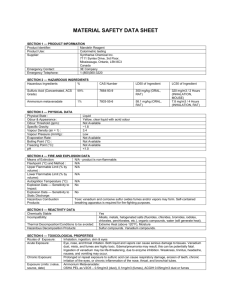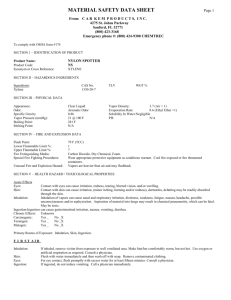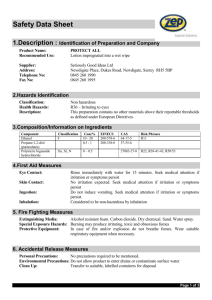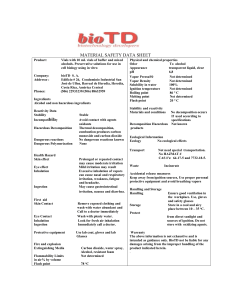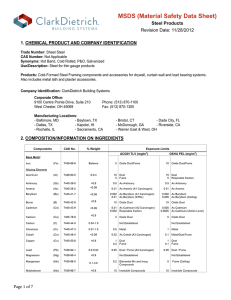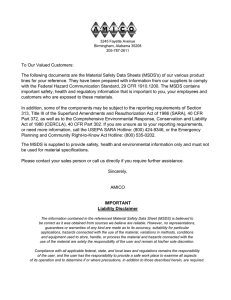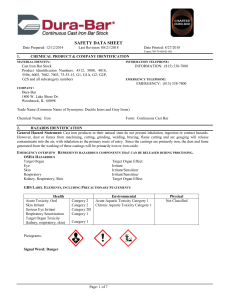Steel Chips - Powder Technology Inc.
advertisement
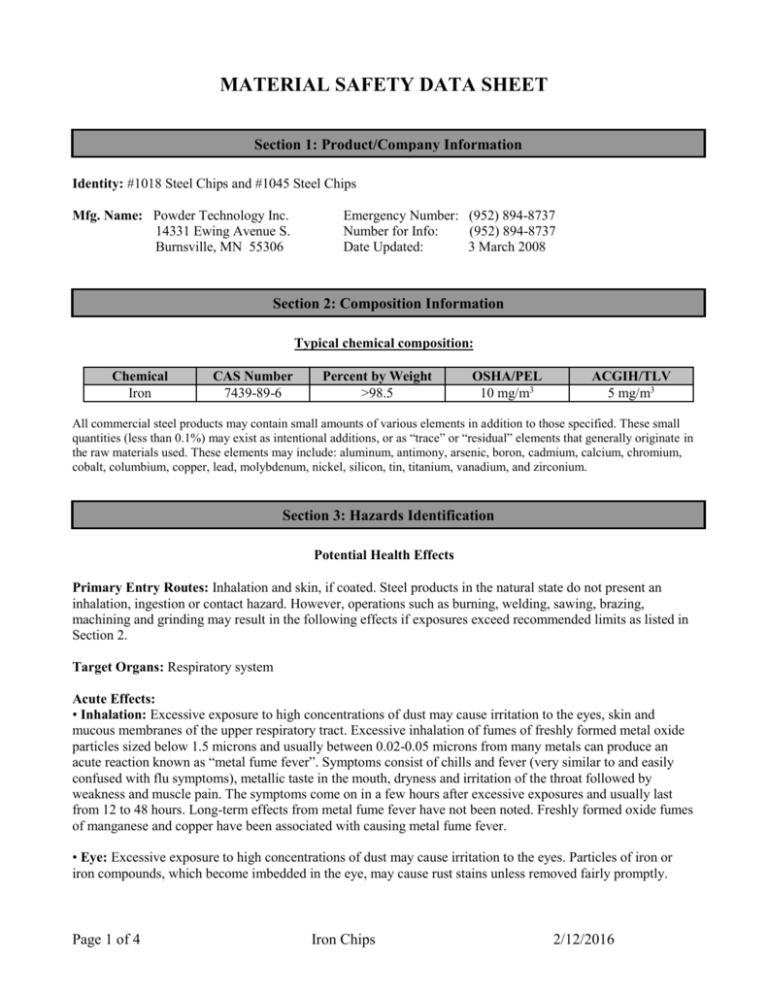
MATERIAL SAFETY DATA SHEET Section 1: Product/Company Information Identity: #1018 Steel Chips and #1045 Steel Chips Mfg. Name: Powder Technology Inc. 14331 Ewing Avenue S. Burnsville, MN 55306 Emergency Number: (952) 894-8737 Number for Info: (952) 894-8737 Date Updated: 3 March 2008 Section 2: Composition Information Typical chemical composition: Chemical Iron CAS Number 7439-89-6 Percent by Weight >98.5 OSHA/PEL 10 mg/m3 ACGIH/TLV 5 mg/m3 All commercial steel products may contain small amounts of various elements in addition to those specified. These small quantities (less than 0.1%) may exist as intentional additions, or as “trace” or “residual” elements that generally originate in the raw materials used. These elements may include: aluminum, antimony, arsenic, boron, cadmium, calcium, chromium, cobalt, columbium, copper, lead, molybdenum, nickel, silicon, tin, titanium, vanadium, and zirconium. Section 3: Hazards Identification Potential Health Effects Primary Entry Routes: Inhalation and skin, if coated. Steel products in the natural state do not present an inhalation, ingestion or contact hazard. However, operations such as burning, welding, sawing, brazing, machining and grinding may result in the following effects if exposures exceed recommended limits as listed in Section 2. Target Organs: Respiratory system Acute Effects: • Inhalation: Excessive exposure to high concentrations of dust may cause irritation to the eyes, skin and mucous membranes of the upper respiratory tract. Excessive inhalation of fumes of freshly formed metal oxide particles sized below 1.5 microns and usually between 0.02-0.05 microns from many metals can produce an acute reaction known as “metal fume fever”. Symptoms consist of chills and fever (very similar to and easily confused with flu symptoms), metallic taste in the mouth, dryness and irritation of the throat followed by weakness and muscle pain. The symptoms come on in a few hours after excessive exposures and usually last from 12 to 48 hours. Long-term effects from metal fume fever have not been noted. Freshly formed oxide fumes of manganese and copper have been associated with causing metal fume fever. • Eye: Excessive exposure to high concentrations of dust may cause irritation to the eyes. Particles of iron or iron compounds, which become imbedded in the eye, may cause rust stains unless removed fairly promptly. Page 1 of 4 Iron Chips 2/12/2016 • Skin: Skin contact with dusts may cause irritation or sensitization, possibly leading to dermatitis. • Ingestion: Ingestion of harmful amounts of this product as distributed is unlikely due to its solid insoluble form. Ingestion of dust may cause nausea or vomiting. Chronic Effects: Chronic inhalation of metallic fumes and dusts are associated with the following conditions: IRON OXIDE: Chronic inhalation of excessive concentrations of iron oxide fumes or dusts may result in the development of a benign pneumoconiosis, called siderosis, which is observable as an X-ray change. No physical impairment of lung function has been associated with siderosis. Carcinogenicity: The International Agency for Research on Cancer (IARC), the National Toxicology Program (NTP), and OSHA do not list steel products as carcinogens. Medical Conditions Aggravated by Long-Term Exposure: Individuals with chronic respiratory disorders (i.e., asthma, chronic bronchitis, emphysema, etc.) may be adversely affected by any fume or airborne particulate matter exposure. SARA Potential Hazard Categories: Immediate Acute Health Hazard; Delayed Chronic Health Hazard. Section 4: Emergency and First Aid Eyes: Flush eyes with plenty of water, lifting the upper and lower eyelids. Seek medical attention if irritation continues. Skin: Wash skin with soap and water. Inhalation: Move exposed person to fresh air. Perform artificial respiration if breathing has stopped. Seek medical attention. Ingestion: Seek medical attention immediately. Section 5: Hazard Identification Flash Point: Not applicable LEL: Not applicable Flash Point Method: Not applicable UEL: Not applicable Burning Rate: Not applicable Auto-ignition Temperature: Not applicable Flammability Classification: Non-flammable, non-combustible Extinguishing Media: Not applicable for solid product. Use extinguishers appropriate for surrounding materials. Unusual Fire or Explosion Hazards: Not applicable for solid product. Do not use water on molten metal. Hazardous Combustion Products: At temperatures above the melting point, fumes containing metal oxides and other alloying elements may be liberated. Fire-Fighting Instructions: Do not release runoff from fire control methods to sewers or waterways. Fire-Fighting Equipment: Wear a self-contained breathing apparatus (SCBA) with a full facepiece operated in pressure-demand or positive pressure mode and full protective clothing. Page 2 of 4 Iron Chips 2/12/2016 Section 6: Accidental Release Measures Spill/Leak Procedures: For spills involving finely divided particles, clean-up personnel should be protected against contact with eyes and skin. If material is in a dry state, avoid inhalation of dust. Fine, dry material should be removed by vacuuming or wet sweeping methods to prevent spreading of dust. Do not release into sewers or waterways. Collect material in appropriate, labeled containers for recovery or disposal in accordance with federal, state, and local regulations. Section 7: Physical/Chemical Data Physical State: Solid Appearance and Odor: Metallic Gray, Odorless Vapor Pressure: Not applicable Vapor Density (Air=1): Not applicable Density: 7.85 gm/cc Specific Gravity (H2O=1, at 4 °C): 7.85 pH: Not applicable Water Solubility: Insoluble Other Solubilities: Not applicable Freezing/Melting Point: ~2750 ºF Section 8: Exposure Control/Personal Protection Ventilation: Keep dust levels below occupational exposure limits. Use local exhaust ventilation if necessary. Personal Protective Equipment: o Eyes: Wear safety goggles or glasses with side shields. o Skin: None required. Protective gloves will minimize exposure. o Inhalation: Use local ventilation. Use OSHA approved respirator if required. Section 9: Stability and Reactivity Data Stability: Steel products are stable under normal storage and handling conditions. Polymerization: Hazardous polymerization cannot occur. Chemical Incompatibilities: Will react with strong acids to form hydrogen. Iron oxide dusts in contact with calcium hypochlorite evolve oxygen and may cause an explosion. Conditions to Avoid: Storage with strong acids or calcium hypochlorite. Hazardous Decomposition Products: Thermal oxidative decomposition of steel products can produce fumes containing oxides of iron and manganese as well as other alloying elements. Section 10: Handling and Storage Handling Precautions: Operations with the potential for generating high concentrations of airborne particulates should be evaluated and controlled as necessary. Practice good housekeeping. Avoid breathing metal fumes and/or dust. Page 3 of 4 Iron Chips 2/12/2016 Section 11: Toxicological Information Eye Effects: Eye contact with the individual components may cause particulate irritation. Implantation of iron particles in guinea pig corneas have resulted in rust rings with corneal softening about rust ring. Skin Effects: Skin contact with the individual dust components may cause physical abrasion, irritation, dermatitis, and sensitization. Acute Inhalation Effects: Inhalation of the individual alloy components has been shown to cause various respiratory effects. Acute Oral Effects: No data available Other: Iron LD50: 30 g/kg oral (rat). Chronic Effects: See Section 3. Carcinogenicity: Nickel. See Section 3. Mutagenicity: No data available Teratogenicity: No data available Section 12: Ecological Information Eco-toxicity: No data available for the product as a whole. However, individual components of the product have been found to be toxic to the environment. Metal dusts may migrate into soil and groundwater and be ingested by wildlife. Environmental Fate: No data available. Environmental Degradation: No data available. Section 13: Disposal Considerations Steel scrap, dusts and fumes should be recycled whenever possible. All disposal methods must be in accordance with all Federal, State/Provincial and local laws and regulations. Regulations may vary in different locations. Waste characterization and compliance with applicable laws are the responsibility solely of the waste generator. Section 14: Transportation Data Not regulated by DOT. Section 15: Other Regulatory Information NONE Section 16: Other Information The information and recommendations contained herein are based upon data believed to be correct. However, no guarantee or warranty of any kind, express or implied, is made with respect to the information contained herein. It is the user’s obligation to determine the conditions of safe use of this product. Page 4 of 4 Iron Chips 2/12/2016
